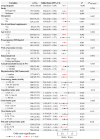Association Between Dietary Soy Isoflavones Intake and the Risk of Hyperemesis Gravidarum: A Cross-Sectional Study in Chinese Pregnant Women
- PMID: 40219039
- PMCID: PMC11990840
- DOI: 10.3390/nu17071282
Association Between Dietary Soy Isoflavones Intake and the Risk of Hyperemesis Gravidarum: A Cross-Sectional Study in Chinese Pregnant Women
Abstract
(1) Background: Diet plays a crucial role in the intake of phytoestrogens, which are closely related to the pathogenesis of some pregnancy complications. However, no studies have explored the potential association between soy isoflavones, a type of phytoestrogen, and the risk of hyperemesis gravidarum (HG). This study aims to investigate the correlation between dietary intake of soy isoflavones and the risk of HG. (2) Methods: As part of the China Birth Cohort Study (CBCS), 2418 pregnant Chinese women (mean age: 31.2 ± 3.4 years) were enrolled between April 2021 and September 2022. Dietary intake was evaluated using a validated 108-item semi-quantitative food frequency questionnaire, with soy isoflavones intake estimated based on five food groups. HG was defined as a condition characterized by a pregnancy-specific vomiting score (PUQE) ≥ 13, weight loss of ≥5% due to severe nausea and vomiting before 16 weeks of gestation, inability to eat or drink normally, significant limitations in daily activities due to severe nausea or vomiting, or the need for hospitalization caused by the condition. The association between soy isoflavones intake and HG was analyzed using binary logistic regression and restricted cubic spline regression. (3) Results: Among all participants, 212 women (8.8%) were diagnosed with HG. The dietary intake of soy isoflavones was 14.56 (IQR: 9.89, 25.36) mg/d. After full adjustment for confounding factors, the results indicated that individuals with the highest dietary intake of soy isoflavones had a lower risk of developing HG (OR: 0.56, 95% CI: 0.36, 0.88. Ptrend = 0.012). (4) Conclusions: Higher dietary intake of soy isoflavones is associated with a reduced risk of HG. We advocate for a dietary approach to the management of HG that prioritizes the intake of legume-rich foods, particularly those abundant in soy isoflavones.
Keywords: dietary soy isoflavones; hyperemesis gravidarum; legumes; soy isoflavones; soybeans.
Conflict of interest statement
None of the authors had any personal or financial conflicts of interest.
Figures


Similar articles
-
Association between Dietary Inflammatory Index and Hyperemesis Gravidarum.Nutrients. 2024 Aug 8;16(16):2618. doi: 10.3390/nu16162618. Nutrients. 2024. PMID: 39203755 Free PMC article.
-
Association of Antioxidant Diet with Risk of Hyperemesis Gravidarum Among Chinese Pregnant Women: A Population-Based Cross-Sectional Study.Nutrients. 2025 Feb 6;17(3):598. doi: 10.3390/nu17030598. Nutrients. 2025. PMID: 39940458 Free PMC article.
-
Norwegian PUQE (Pregnancy-Unique Quantification of Emesis and nausea) identifies patients with hyperemesis gravidarum and poor nutritional intake: a prospective cohort validation study.PLoS One. 2015 Apr 1;10(4):e0119962. doi: 10.1371/journal.pone.0119962. eCollection 2015. PLoS One. 2015. PMID: 25830549 Free PMC article.
-
Association between Dietary Isoflavones in Soy and Legumes and Endometrial Cancer: A Systematic Review and Meta-Analysis.J Acad Nutr Diet. 2018 Apr;118(4):637-651. doi: 10.1016/j.jand.2016.09.036. Epub 2016 Dec 1. J Acad Nutr Diet. 2018. PMID: 27914914
-
What is known about the nutritional intake of women with Hyperemesis Gravidarum?: A scoping review.Eur J Obstet Gynecol Reprod Biol. 2021 Feb;257:76-83. doi: 10.1016/j.ejogrb.2020.12.003. Epub 2020 Dec 10. Eur J Obstet Gynecol Reprod Biol. 2021. PMID: 33360613
References
-
- Ali A.I., Nori W., Abdulrahman H.B. Hyperemesis gravidarum and risks of placental dysfunction disorders. J. Pak. Med. Assoc. 2021;71((Suppl. S9)):S24–S28. - PubMed
-
- Nijsten K., Jansen L., Limpens J., Finken M., Koot M.H., Grooten I.J., Roseboom T.J., Painter R.C. Long-term health outcomes of children born to mothers with hyperemesis gravidarum: A systematic review and meta-analysis. Am. J. Obstet. Gynecol. 2022;227:414–429. doi: 10.1016/j.ajog.2022.03.052. - DOI - PubMed
MeSH terms
Substances
Supplementary concepts
LinkOut - more resources
Full Text Sources
Research Materials
Miscellaneous

